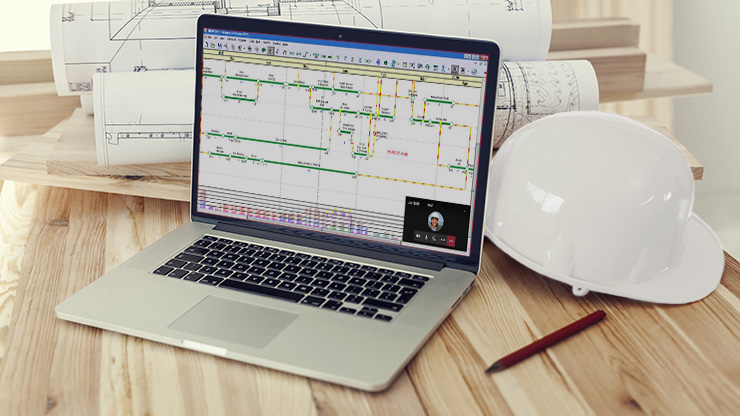At the outset of 2020, the global construction industry was predicted to grow by 3.1%. As the year progresses, construction project managers are dealing with situations heretofore unprecedented in their professional experience.
As we will discover, the current COVID-19 situation impacts project delivery, risk management, the project schedule, stakeholder communication, and many other aspects of the industry. While we may see projects postponed in the short term, in the long term, this crisis will demand safety enhancements to buildings and processes that can only be provided by new engineering and construction projects.
A major adaptation to the new environment will be an ever-growing need for project professionals who will manage their teams remotely. With technology comes convenience, as well as many novel challenges.
If you’re a project manager who needs help with managing remote teams, here’s a brief guide for remote construction project management.
Find a Good Communication Platform

When you need to manage a team remotely, it goes without saying that you need to put technology to good use. But sometimes, people overutilize the technology, or have too many tools, and these can be more confusing than helpful. So best practices dictate sourcing and utilizing a few good programs to prevent chaos.
The first priority is finding a good communication platform. Without communication, the project would undoubtedly come to a standstill.
This platform should be the central tool for communication between you and your workers. Use both chat and video conferencing to get daily updates, as well as have one-on-ones.
Use the program for building relationships as well. Many remote project managers risk losing the human element when communication is only screen-based. You can’t really have a chat with your colleagues by the water cooler.
If the communication platform has a chat function, then consider setting up a non-work channel. This can effectively serve as a digital water cooler, which allows workers to blow off some steam and get to know one another.
Make sure you get to know your team members in other ways; for example, if you have one-on-one meetings, take a few minutes at the start to ask how things are going with them. This can help you build relationships and have a more cohesive, loyal, and hardworking team.
Use Project Management Software
How many times have you set a timeline for your project, only for it to fall behind more and more as time went on? Managing projects with in-person teams is already tough enough, but when you start working remotely, it can get even more challenging.
Sourcing the best project management software for your project and using it before you even get started is vital. Once you’ve determined team assignments, delegate those tasks on the program so everyone gets a clear picture of what needs to be done, and when. Rather than focus on how much time your team spends on certain tasks, focus on accomplishing objectives in accordance with the set timeline.
A central feature of project management software is accessibility from practically anywhere; many have mobile apps as well. This means all team members can quickly pull up the timeline, find out if everyone’s done their part, and take over when it’s time for them to jump into action.
This accessibility can help significantly with keeping the project moving instead of coming to a standstill because of miscommunication of task start dates. It can also cut down on people waiting around for others to “pass the baton,” as the software will enable workers to easily check off tasks and notify the next person down the line.
Communicate the Project Plan

Selecting a planning tool that can graphically display the project activities and tasks on-screen will ensure your team understands the current and future states of the project. The more interactive and dynamic the application, the better you will engage your team.
Using your communication platform, summon your team to plan and schedule your projects on optimally user-friendly and visually impactful planning software. NetPoint was created by construction scheduling professionals to optimize project management and team collaboration. NetPoint provides a highly interactive experience in which all stakeholders on the project can be actively engaged and contribute to project planning.
By contrast, team members often become overwhelmed when looking at a P6 schedule, so they do not feel empowered to discuss it. P6 is designed to have multiple activities linked on different pages that are difficult to discern from a printout.
NetPoint, a real-time planning and scheduling application, is a great tool to summarize multi-page schedules into one page or screen. NetPoint allows project managers to show a project from a very high level. The graphical interface is markedly different from the tabular format that P6 and Microsoft Project provides.
In a nutshell, NetPoint displays a canvas for you to draw the network logic. There are no columns to match up, and you can see the actual flow of the work. During project planning or execution as task changes occur, NetPoint helps you move activities and adjust durations effortlessly, instantly propagating all changes to the entire network. All objects and data elements update with any schedule modification in real-time.
Best of all, NetPoint provides all stakeholders with a deeper insight into the activities with the greatest impact to the project schedule and completion.
Interactive Planning Sessions
NetPoint is ideal for Interactive Planning Session (IPS) because it helps project stakeholders agree on a plan of action, reach commitment, and align teamwork. This process includes designers, CMs, commissioning agents, and others who can collaboratively identify milestones in design, construction, and commissioning.
For example, if the design team sets a goal to issue a set of documents by a certain date, but the construction manager needs that information one month prior, the team must agree on an alternate solution. This type of team-wide collaboration allows for greater efficiency and planning for all parties involved and ultimately saves time and money.
NetPoint’s intuitive graphical interface and hands-on interaction show the immediate impact and result of every decision. Like Activity Network diagrams of the past, NetPoint brings the focus back to a network view that is easy for everyone to understand. NetPoint can develop solutions and help the team solve problems together in real-time, even when working remotely.
Consider Resource Management and Employee Scheduling Software
Construction project managers are faced with the challenge of prioritizing and optimizing a wide array of resources. Resources can take the form of human labor, equipment, capital/costs, or material. These resources must be accurately forecast, tracked, and measured to keep the project on schedule.
NetPoint is an excellent project scheduling software for managing time and resources. NetPoint allows you to clearly define any task lists or resources you need to execute your projects.
Cost-loading tasks are accomplished through the resource functionality. Furthermore, by plotting resource histograms and curves directly underneath activities, resource leveling in NetPoint becomes a truly interactive and engaging exercise.
Project team members and contractors are one of the most important resources on a project and managing them requires time and energy. You might be used to scheduling your employees manually. But not only is this time-consuming, but it can also become disorganized.
A simple way to improve employee scheduling is to use dedicated human resource scheduling software. This prevents overlaps and enables you to send out schedules easily.
A good program also gives you a great overall view so you can identify any areas that are lacking. You can then find workers who are available and assign them accordingly. In addition, many programs integrate with HR and accounting software, which means you can eliminate extra steps for payroll.
The right employee scheduling software can streamline and improve this aspect of project management for your company.
Meet in Person When Possible
While adopting great pieces of technology can be excellent for managing remote projects, technology can never replace face-to-face human interaction. Even if it’s just once or twice a year, it’s important to meet with your team in person when possible.
Face-to-face meetings help you build rapport and a better relationship with your workers. You can also use this opportunity to celebrate milestones and recognize those who have worked hard and made great achievements. Not only will this make them feel appreciated, but it can also show your team that you’re a project manager who actually cares and pays attention to their efforts.
Meeting in person can also help align visions and goals more easily. Webcams can convey only a limited view; when you can get together in person, the process is much simpler.
Moreover, some people may feel more comfortable voicing concerns with you in person. If that happens, make sure you have an open ear. Don’t just listen; set processes in motion to address those concerns and make their workplace safer and more comfortable.
Manage Remote Construction Projects Efficiently
As you can see, remote construction project management can be handled successfully with the right processes and by leveraging technology. Take some time to experiment with different programs and once you figure out what works for your team, stick with it.
Working remotely already comes with its own unique set of hurdles, and you don’t want to further complicate things by swapping tech halfway. Get it right in the beginning, and you’ll see your project move along smoothly in the future. And don’t forget: one of the most important things is to have open communication and transparency.
Need help with your remote construction team? Then get in touch with us now.